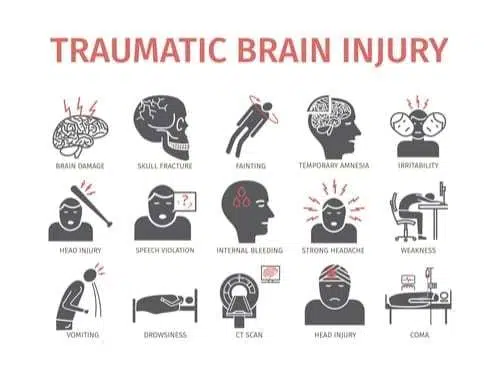
This post discusses classification of and types of brain injury. If you or someone you care for has sustained a traumatic brain injury (tbi) from a car accident or other trauma, read on for more information.
This article is not intended as medical advice regarding traumatic brain injury. Please seek immediate medical treatment for your brain injury if you have not done so already.
The Bishop Law Firm represents car accident, personal injury and workers' compensation clients in North Carolina and we do not get paid unless we win your case.
Types of Brain Injury
The brain is the most complex organ of the human body and many things about the brain are still a mystery. Brain injury, like the brain itself, is complicated. This post discusses acquired brain injury from trauma. You can have one or several types of traumatic brain injury from one unfortunate blow to the head. There is a primary brain injury (the actual brain trauma) and a secondary brain injury (a cellular process).
- Concussions – are caused by a bump, blow or jolt to the head that makes the brain move inside the cranium resulting in disruption of the brain’s normal functioning. Headaches, confusion, dizziness and nausea are all symptoms of a concussion (Via CDC ). Even a “mild” concussion can cause serious symptoms that show up immediately or over the days following your injury. You don’t have to physically be hit in the head to sustain a concussion.
- Contusion - is a bruise on the brain that can cause swelling and may result in a hematoma or cerebral edema. Both concussions and contusions are closed head injuries (no penetration).
- Hematomas – A hematoma can be located inside the brain ( intracranial ) or outside the brain (subdural hematoma ). A blow to the head or a burst blood vessel (hemorrhagic stroke) can cause blood to pool inside or outside the brain. Either way, these types of brain injuries can be life threatening and need to be addressed immediately. As the blood pool increases the side effects increase from headaches to seizures and then to unconsciousness. Surgery may be needed to drain the blood quickly.
- Cerebral Edema – Your brain can swell after an injury. The swelling increases pressure in the brain and can also prevent fluids from flowing correctly causing even more intracranial pressure. Headaches, neck pain, inability to walk, seizures, dizziness and memory loss are all symptoms. A CT scan or MRI is needed to diagnose brain swelling (Via WebMD ).
- Skull Fracture – There are four types of skull bone fractures: linear, depressed, diastatic and basilar (Via John Hopkins ).
- Linear skull fractures – this is the most common. The bone breaks but does not move. Usually, no treatment is needed.
- Depressed skull fractures – a part of the skull has sunken in (depressed) due to the trauma. Surgery may be needed depending on how deep the depression.
- Diastatic skull fractures – common in newborns and infants
- Basilar skull fractures – the most severe type of skull fracture. A portion of the brain has been exposed and bruising under the eyes/behind ears is noticeable.
- Coup-contrecoup Injury – Unfortunately when one side of your brain (coup) is hit hard enough, it pushes the brain to the other side of the skull causing damage on that side as well (contrecoup). A coup-contrecoup can cause brain damage of both sides of the brain even though only one side of the brain was hit (Via NorthEastern University ).
- Diffuse Axonal Injury – results from a blunt blow to the brain that affects white matter. A diffuse axonal injury is diagnosed if the victim scores less than 8 on the Glascock Coma Scale ( GCS ) for more than six hours (Via NCBI ). The GCS uses patient eye, verbal and motor responses to establish the level of consciousness of patients with an acute brain injury.
- Penetrating brain injury – less common but carries a worse prognosis than a closed head injury. X-rays, CTs and MRIs are used to detect the penetration. A craniotomy or craniectomy can be performed but there may be long term complications such as post-traumatic seizure disorder (Via NCBI ).
- Hypoxia and Anoxia brain injury – Hypoxia (oxygen deprivation) and eventually, Anoxia occur when the brain does not get enough oxygen. Within five minutes after oxygen supply has been cut off brain cells start to die (Via NIH ) resulting in brain damage.
- Chiari Malformation – occurs when brain tissue extends into the spinal canal because of pressure. Read more at Arnold-Chiari Malformation After Injury.
- Hydrocephalus – As the name implies, hydrocephalus means “water on the brain”, except the water is really cerebrospinal fluid (CSF). CSF is a clear fluid that surrounds the brain and spinal cord providing vital protection. When there is too much of this fluid, pressure is put on the brain.
Classification of Brain Injuries
The Mayo Clinic breaks traumatic brain injury into mild, moderate and severe categories while the GCS (discussed above) helps more with those in a coma. But, simply because a brain injury is classified as mild does not mean that there are no serious symptoms.
A mild TBI can cause loss of consciousness, headaches, fatigue, dizziness, problems speaking, memory issues and even serious depression. With a moderate to severe TBI, symptom severity increases. Each part of the brain controls a different aspect of the human body and every brain injury is different.
Severe head injury can leave a victim with the need for long term brain injury rehabilitation due to altered brain function. Be sure to tell your doctor about all your or your loved one's symptoms, even those that seem sporadic.
The Bishop Law Firm represents car accident, personal injury and workers' compensation clients in Raleigh, Durham, Rocky Mount, Wilson, Smithfield, Louisburg, Chapel Hill, Roanoke Rapids, and surrounding areas in North Carolina. Call us today for a free case evaluation, (919) 615-3095 or for more information read:
NC Traumatic Brain Injury Attorney ; NC Car Accident Lawyer; NC Personal Injury Lawyer

